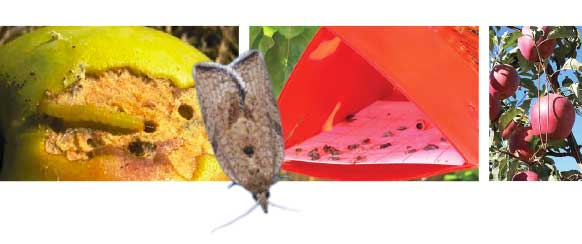The light brown apple moth (LBAM) is a native Australian leaf roller with a wide host range including fruit crops, broadleaf pasture and weed species.
It can cause significant damage to temperate fruit crops, particularly in cool climate growing regions.
Pest identification
Adult moths are pale brown and about 10 mm long.
Caterpillars start yellow and become green with a brown head. Pupae are 10–12 mm long and turn from green to brown. Egg masses can be green to yellow–brown.
LBAM do not survive well at high temperatures and are therefore more likely in cooler areas with mild summers. Feeding and pupation sites in fruit are usually accompanied by webbing.
Damage
Larvae (or caterpillars) feed between fruit or under leaves webbed to the fruit, chewing the fruit surface. This damage results in fruit being downgraded during sorting and packing.
Monitoring
Monitor for LBAM using pheromone traps; start before flowering.
Use trap catches to determine a biofix date (first sustained flight).
Start fruit inspections in mid to late spring, especially among fruit clusters and under leaves as LBAM usually feeds in sheltered sites.
To identify the timing of LBAM egg lay, inspect foliage, but the egg masses can be hard to spot.
Management
Cultural and physical
Reduce broadleaf weeds such as capeweed (Arctotheca calendula) and dock (Rumex spp.) as LBAM can overwinter in these.
Thinning pome and stone fruits to singles where practical (whilst maintaining an appropriate crop load) will reduce the number of suitable feeding sites for LBAM.
Biological
Trichogramma carverae is a commercially available parasitic wasp for LBAM control.
Natural predators such as other parasitic wasps, lacewings, spiders and predatory shield bugs also contribute to the biological control of LBAM.
Bacillus thuringiensis (Bt) is a naturally occurring bacteria that is toxic to LBAM larvae when consumed, therefore is an effective biological control method.
Pheromone ties placed in the orchard at a rate of 500–600/ha can be an effective non-chemical management tool. They flood the orchard with pheromones to confuse the male moths, disrupting mating and subsequent egg lay.
Download the Orchard plant protection guide
See this article in Tree Fruit Oct 2021




















